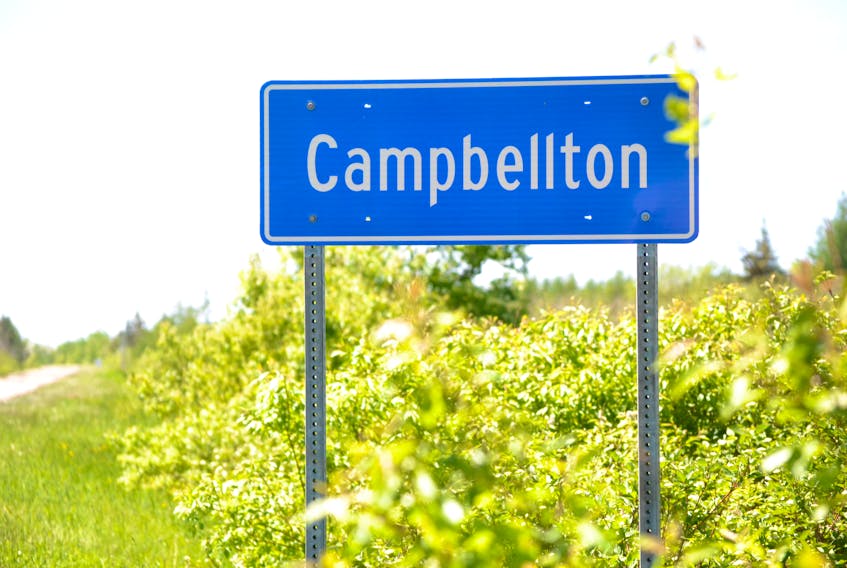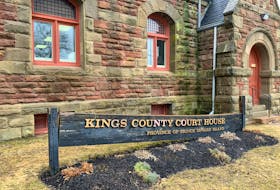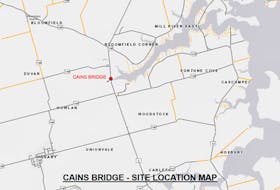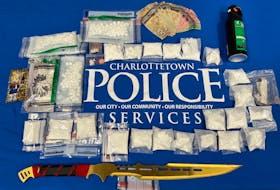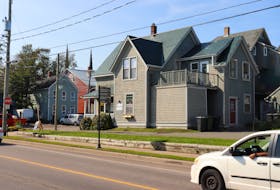CAMPBELLTON, P.E.I. — Standing beside the Campbellton United Church, John Cousins talks about walking on a low-pitched roof above.
That covering cannot be seen from outside, however. It is hidden under a higher roof.
It’s kind of like history — Cousin’s passion — one has to look beneath the surface to find it.

Cousins, a P.E.I. historian, tells the story of the structure.
It dates back to the early 1840s when merchant James MacLauchlan built a store.
It was the first of several shops in the community which was then called O’Halloran after a family from Tralee, Scotland.
This store’s run was brief, as MacLauchlan was lost at sea sailing to the Miramichi for a load of rum, a staple in merchant stores of the era.
Within a few years, the area’s growing Presbyterian population adopted the store as a church.
It remained where, and how, MacLauchlan built it until 1902. That’s when the congregation hired one of the region’s best carpenters to move and renovate the building, adding a steeple and the high roof.
“His name was John Doyle,” Cousins says. “He was a good Irish Catholic, which will tell you something about the relationship between the two communities.”
Those two communities are the Lot 4 section of Campbellton, where the United Church is located, and the Lot 7 section of Campbellton.
At a glance
- John Cousins has devoted much research to area’s folklore and folksongs.
- O’Halloran Road is one of the most popular tunes he has recorded himself.
- It was composed in the 1880s by Dan Riley.
- Cousins learned the song from his mother, Mary, who would’ve heard it being sung about a century ago.
Even before the church was established, MacLauchlan’s house had been converted into the community’s first school.
One of the first school teachers was Alexander Campbell. Modern-day Campbellton is named after him.
“From the fact that the community changed its name, that could only have come from the people having a meeting, likely in the school,” Cousins shares.
Campbell obviously had an impact on the community for residents to name their school after him, he said.
There is a record of three of Campbell’s young daughters dying within days of each other in the early 1850s, likely from some health epidemic.
Cousins says more research is needed to find out where the teacher ended up.
A new school was built down by the shore in the 1860s. In 1945, it was relocated, less than a kilometre, to be more central to a growing population along O’Halloran Road. It closed in 1970.
Cousins says immigrants from the Kerry, Cork, Waterford and Wexford counties of Ireland began arriving along the Lot 7 coastline stretching from Campbellton to West Cape in the early 1820s.
“In Lot 4, a different group of pioneers, a few years later, moved in. They were mostly Scots, and they were Presbyterians. You had the Irish Catholics up the shore, but people like the MacKendricks and MacKays, MacDougalls and the Rileys – they settled on farms along what is now called the O’Halloran Road.”
Lots 4 and 7 had different landowners. Mostly the landowners leased farmland. Perpetual, 999-year leases were common. For a short time, though, the Lot 7 landowner sold farm property to Irish settlers.
Lots 4 and 7 were distinct religiously, Cousins said, but that was never an issue.
“Catholic and Protestant coexisted in that community, going now very close to 200 years.”
The community roots were in farming and fishing. It boomed in the 1860s and 70s when shipbuilding peaked.
Vessels were built and launched right on the shore in Campbellton.
They were loaded with lumber and sailed across the Atlantic where they were sold to the English, cargo and all.
Fishing and shipbuilding in Campbellton employed hundreds, Cousins says. And farming once flourished. The fact there were once two blacksmith shops is a sign of the industry’s strength.
The last of the big ships built in Campellton, the James H. Myrick, was launched from the Campbellton shore, fully rigged, in 1877.
“She was a beautiful ship. She would’ve been 150 feet long. The mast in her would’ve been over 100 feet high.”
There was also a saw mill, cheese factory, fox farming, stores and the Aberdeen Hotel.
Then the boom ended.
“Like all communities, it wilted. It began wilting in the early 1950s. The fishing was poor. Young people were leaving. The population wasn’t replacing itself.”

The mixed farm has all but disappeared, he notes, and small communities are getting even smaller.
He remembers there being 54 children in Campbellton’s one-room school when he was in Grade 4, and that number does not account for the children of the community who would’ve dropped out.
Today in Campbellton, there are four school-aged children.
“When people became mobile with cars, from the 1950s on, the stores began to close.”
The blacksmith shops and other local services disappeared.
While Cousins says it was a blow to the smaller communities when consolidation bussed the older children out to school, it was a “stake through the heart” when the young children started being bussed to larger centres.
“There’s no sense lamenting cultural change, however, what there is sense in doing — and I would emphasize this — is attempting to be aware of where you came from today.”
Cousins says every community has stories to share.
“Every one of them had their histories. The histories of their families, the histories of their church, the histories of the businesses. Every one of them.”
It’s likely many of them have a building or two with hidden low-pitched roofs.

Island history being lost
John Cousins fears the history of many rural communities is in danger unless more take an intense interest in it.
“There are thousands of communities in the Maritimes,” the P.E.I. historian notes.
“We owe these people (who settled in and built these communities). These were good people. These were people who worked, and lived, alongside of one another and lasted for generations, and endured.
“And now we forget their names, even. We don’t even give them the courtesy of remembering the names of the people who built these communities. And it’s sad.”
The 74-year-old Campbellton, P.E.I. native, who today lives in the neighbouring community of Bloomfield, adds that the amount of change happening is coming with a cost, and information is disappearing.
“The gap between present and past is like a cement wall a mile high between the present and even 1965.”
“Historians, we’re like the farmers. There are less of us. There are less of us being hired in universities. There are less of us taking history in university and I don’t see a solution to this at this point, any more than the people who were living in a farming society that was dying could see any solution. I think it is sad.”
-John Cousins
Cousins has devoted much of his life to historical research near and far.
Those efforts have led him to holding community historians in high esteem. He says they keep oral and written heritage alive.
He says there were many such histories written in the 1970s.
He lauds those who took on the task of compiling them, community-minded individuals like Eva MacNevin who wrote the history of the community of Brae.
A more recent example of a community history is “Threads of the Past, the History of O’Leary.”
A committee of five area school teachers formed in 1991 and chronicled from 1837 to 1992.
Alden Weeks is the only surviving member of that committee.
He has been continually building on that information. He is now up to 2013 with his research and digital storage.
“I clip everything,” he said.
Weeks also relies heavily on the memory of O’Leary resident Florence Turner in his information gathering.
“It’s very time-consuming and a lot of people … they probably don’t want to commit themselves to a long-term project like this,” he says.
According to “Threads of the Past,” the Town of O’Leary owes its name to Michael O’Leary, an Irish immigrant who settled in West Cape in 1837.
He blazed a trail, now known as O’Leary Road, to the opposite coast.
Cousins believes that’s the kind of detail that needs to be preserved.
“All humans act locally, and so local history is very important,” he says.
“Historians, we’re like the farmers. There are less of us. There are less of us being hired in universities. There are less of us taking history in university and I don’t see a solution to this at this point, any more than the people who were living in a farming society that was dying could see any solution. I think it is sad.”
Historian John Cousins grew up in the western P.E.I. community of Campbellton, Lot 4. His home was located a half a kilometre north of the Coughlin Road, the boundary line between the townships of Lot 4 and Lot 7. Journal Pioneer reporter Eric McCarthy also grew up in Campbellton, in Lot 7, less than a kilometre south of the Coughlin Road township boundary line.

